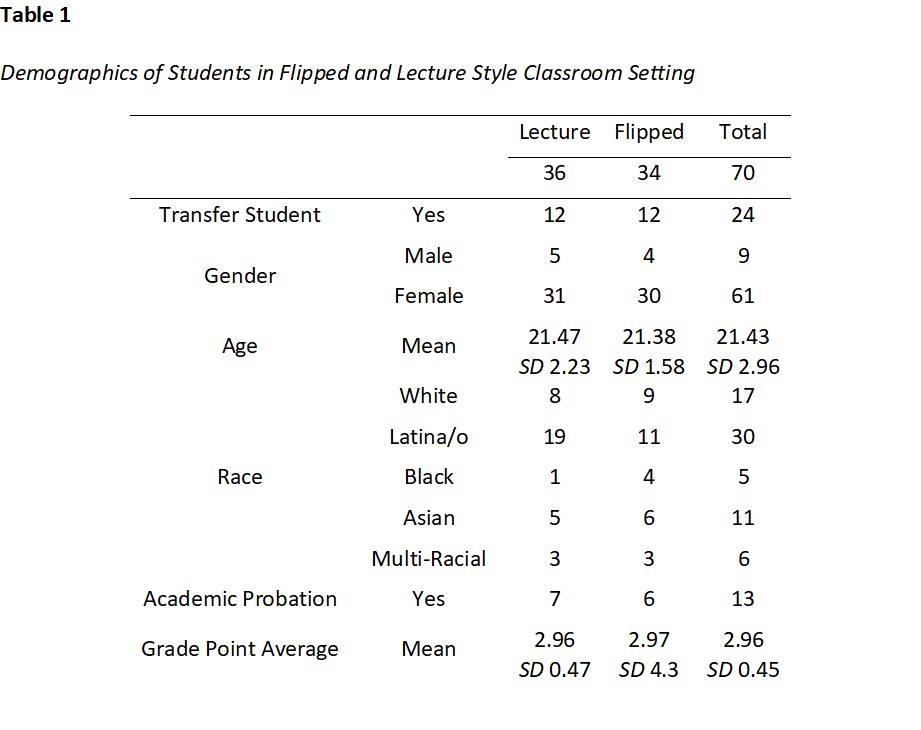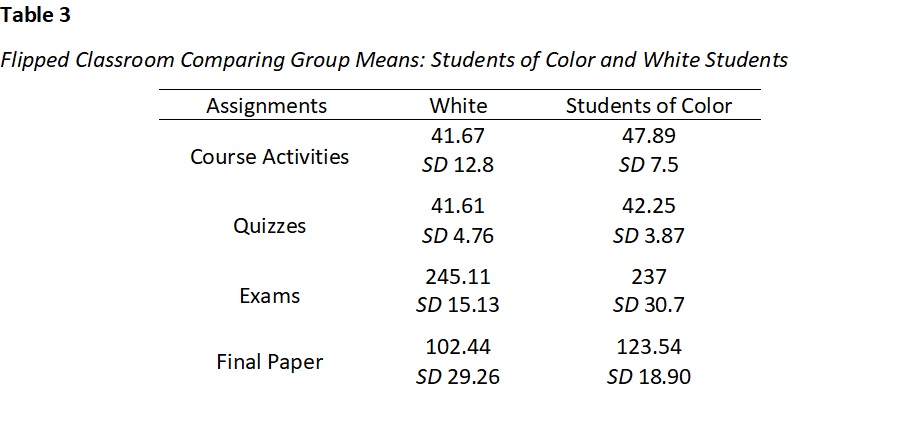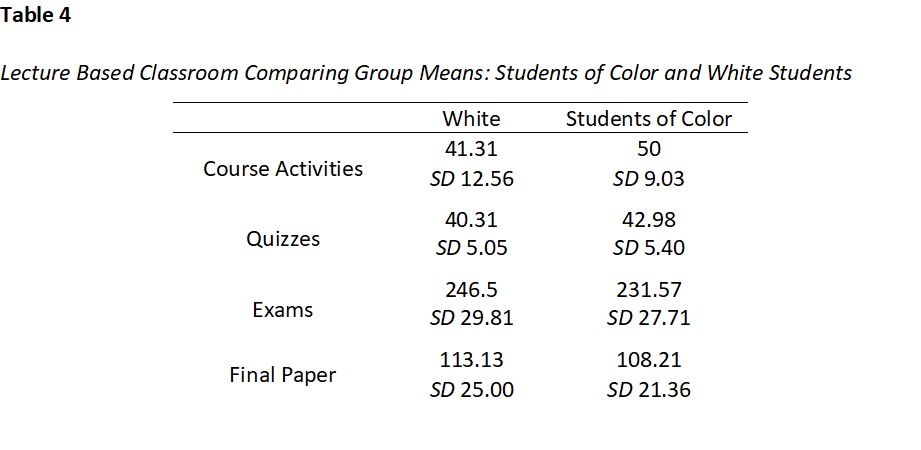Teaching Using a Flipped Classroom Approach: Impacts for Students of Color
Amber M. Gonzalez, Ph.D. (she/her/ella)
California State University, Sacramento
Abstract
Using a quasi-experimental research design this study examined whether the use of a flipped classroom teaching method for undergraduate quantitative research methods had an impact on undergraduate students’ academic achievement within the course as measured by their course assignments, quizzes, exams, and final paper. Findings suggest that utilizing a flipped classroom teaching design impacted Students of Color, as they performed better than their White peers on their final papers.
Keywords: Undergraduate Research Methods, Flipped Classroom, Students of Color
Teaching Using a Flipped Classroom Approach: Impacts for Students of Color
Hispanic Serving Institutions (HSIs) are recognized as Minority Serving Institutions (MSIs), which account for at least 40% of undergraduate Student of Color enrollment (IHEP, 2014). These institutions often create a pathway to college success for students who are first generation, low income, and have been historically disadvantaged in terms of access to success in postsecondary education. Often as we discuss student outcomes at HSIs we focus on enrollment and graduation outcomes without paying particular attention to the path towards graduation and the experiences of Students of Color within the classroom learning environments.
Higher education learning environments are being increasingly investigated as the use of technology within these learning environment increases (Casanova et al., 2020; Goedhard et al., 2019). In addition, technology has changed the ways in which our students think and engage with information (Beichner, 2014).
In a traditional lecture style classroom, the learning environment is often designed by row-by-row seating with the teacher facing the students from a position at the front of the classroom. Using this classroom design environment, the teacher is often viewed as the transmitter of knowledge and students are viewed as passive learners that take in information through note taking and question asking (Casanova et al., 2020). However, as a student-centered teaching approach (McLaughlin et al., 2014), the flipped classroom is an instructional setting characterized by both online and face-to-face instruction (DeLozier & Rhodes, 2017; Roehl et al., 2014). Although there are many models of flipped classroom design the main characteristics include instructional content that has been viewed before class through course readings, concept videos, and/or providing students with detailed notes (DeLozier & Rhodes, 2017; Roehl et al., 2014). Thus, teachers and students are able to spend in class time working on interactive engagement activities (Mitchell, 2020) influencing the development of higher order skills such as application and analysis through the use of problem solving, in depth discussions, or advancing concepts thus allowing for more one-on-one engagement between teacher and student (Nouri, 2016). The use of this model also can provide teachers with an opportunity to gain insight into their students’ learning and understanding of course concepts through in class observations of students’ engagement activity (Mitchell, 2020).
Research examining the use of a flipped classroom design has indicated students who take courses using flipped classroom designs improve student engagement and student learning as measured by student grades (Ball & Pelco, 2006; Nouri, 2016; Peterson, 2016; Pienta, 2016). Moreover, Nouri (2016) found that students felt more motivated as learners when taught using a flipped classroom approach. In addition, Pienta’s (2016) findings suggest that students with low levels of achievement in class are benefitting the most from flipped classrooms. While empirical research has found that utilizing a flipped classroom design is supportive of student learning and has positive impacts on student outcomes (Ball & Pelco, 2006; Nouri, 2016; Peterson, 2016; Pienta, 2016), it is unclear how Students of Color respond to the use of a flipped classroom design.
Teaching Research Methods
Undergraduate research methods courses are aimed at supporting students’ development of critical thinking skills through their understanding of issues associated with conducting research. Often these courses are students’ first experiences with research and have the potential to spark aspirations to pursue post-baccalaureate degrees that focus more on research. However, even if students are not inspired to pursue graduate education at the end of the course, these courses are important in helping students to critically evaluate scientific research to make informed decisions as part of their professional development (Zablotsky, 2001). Despite their importance, undergraduate research methods courses are often perceived by students as challenging and can have a negative impact on students’ academic achievement, motivation, and attitudes towards engaging in research (Ball & Pelco, 2006).
Current Study
Although a flipped classroom design is a relatively new pedagogical design being utilized in higher education settings, there are empirical studies examining the benefits of such a design (Nouri, 2016). However, the minimal literature that does exist looks at students as a whole and does not examine the heterogeneity of our student population. The purpose of this quasi-experimental study was aimed at better understanding how completing a course in undergraduate research methods that flips the traditional lecture/homework pedagogy and utilizes an activity-based learning environment impacts undergraduate students’ academic achievement. Additionally, this study examined how Students of Color differed from their White peers in the achievement within the course.
Method
This study examined group differences, without the ability to randomly assign participants to the different learning environments, therefore employing a quasi-experimental research design (Creswell & Creswell, 2018). Using statistical analysis, the current study evaluated group differences using the learning environment as the quasi-independent variable and course achievement as outcome variables. In addition to examining group differences by learning environment, this study also evaluated the effects of a flipped classroom learning environment on undergraduate students’ course achievement with attention paid to differences for White students compared to Students of Color.
Research Design
The research methods course was aimed at introducing undergraduate students majoring (or minoring) in a developmental psychology program to quantitative research methods. This course is a required foundation course within the program and students within the course were mostly junior level. A pre-requisite to the course is that students must have completed at least 45 units prior to enrollment. Major topics within the course included the structures, design and conduct of quantitative research inquiry, the generation of quantitative research questions and hypotheses, and collection and analysis of quantitative data. Emphasis was placed on challenging students to think critically about methodological issues in quantitative research as it applied to developmental research. Although the overall passing rate of students enrolled in this course is fairly good, approximately 8% of undergraduate students fail the course on a yearly basis and the retention and applicability of the course material for use in future courses is low.
Both sections were taught using the same textbook, covering the same chapters in the same order over a 16-week semester. Students in both sections completed the same amount of course assignments including problem-based activities, quizzes, exams, and a final mini research paper that was application based. Both sections were taught face-to-face for 75 minutes twice a week but on different days of the week. More specifically, students in the flipped classroom met on Tuesday and Thursday early afternoon (12:00pm-1:15pm) whereas students enrolled in the lecture-based course met on Monday and Wednesday early afternoon (12:00pm-1:15pm). Both courses were taught by the same self-identified Latina tenure-track Assistant Professor.
Utilizing a quasi-experimental research design, section A was considered to be the control group, meaning the course was taught by the instructor using a traditional method of face-to-face lecturing in class and providing out of class problem-based activities. In contrast, section B of the course was taught using a flipped classroom design. More specifically, the instructor provided course content via short concept videos and lecture notes that were to be read outside of class and class time was devoted to completing the problem-based activities, as well as working on the final research paper.
Participants
Participants included 70 undergraduate students who self-enrolled in one of two undergraduate quantitative research methods courses in a developmental psychology program during the fall semester of 2018 at a Hispanic Serving Institution (HSI). Students self-enrolled in either a traditional lecture-based course (n = 36) or a course that utilized a flipped classroom design (n = 33). At the time of enrollment, students were unaware of what section they were enrolling it.
On average, during fall 2018, students were enrolled in 14.12 units (SD 2.24) and their grade point average was 2.96 (SD 0.45). It is important to note that students who self-identified as White had an average grade point average of 3.12 (SD 0.38) whereas Students of Color had an average grade point average that was slightly lower at 2.9 (SD 0.46); these differences were not significant (t(62) = 1.7, p = 0.10, two-tailed). Additional demographic information of students in flipped and lecture style classroom settings is provided in Table 1.

Measures
At the start of the semester, students in both sections completed informed consent. At the end of the semester, students were provided with a survey that asked questions about their demographic characteristics, including their student identification number, gender, ethnicity, age, anticipated graduation date, number of units enrolled in and completed, grade point average, whether they have been on academic probation, whether they were a transfer student, and their specific program of study. At the end of the semester, after grades were submitted, students’ demographic data were merged with their grades earned in class (ie. course assignments, quizzes, exams, final paper). Course grades included course problem-based activities with the highest possible score being 60, quizzes with the highest possible score a 48, exams with the highest possible score 300, and a final paper with the highest possible score 150.
Analysis
Descriptive and inferential statistical analysis was conducted using SPSS 27.0 software. Independent sample t-tests were used to determine if there were significant group differences between type of instructional method (i.e. flipped and lecture-based) and students earned grades. In addition, independent sample t-tests were used to examine differences in student achievement among Student of Color and White students within each instructional method.
Findings
At the completion of the semester, overall, students performed well on their course problem-based activities, quizzes, exams, and final paper. Across both conditions, 14.3% of students earned A’s, 37.1% of students earned B’s, 30% of students earned C’s, and 18.6% of students failed the course. Neither classroom setting nor students’ self-identified racial identity were related to earned grades at the end of the semester.
Flipped and Lecture Based Classroom Setting
When comparing students in the flipped classroom setting to the lecture-based setting, there were no significant differences among students in regard to their mean scores on course problem-based activities, quizzes, exams, or final paper. Table 2 provides additional details on student mean scores earned on activities, quizzes, exams, and their final paper.

Classroom Setting: Students of Color and White Students
For the flipped classroom condition, there was a significant difference between White students (M = 102.44, SD = 29.26) and Students of Color (M = 123.54, SD = 18.90) who scored significantly higher on their final paper (t(31) = 2.45, p < .05, two-tailed). When comparing Students of Color and White Students in the flipped classroom setting, Students of Color had higher mean scores for all course problem-based activities and quizzes, however, these mean differences were not significant. White students did perform better on exams than Students of Color, however, these mean differences were not significant. Table 3 provides additional details on student mean scores earned on problem-based course activities, quizzes, exams, and their final paper, by racial type.

When comparing Students of Color and White students, for the lecture-based classroom condition, Students of Color had higher mean scores on course problem-based activities and quizzes, however these mean differences were not significant. In addition, White students performed better on exams and final paper scores, however these mean differences were not significant. Table 4 provides additional details on student mean scores earned on activities, quizzes, exams, and their final paper by racial type for the lecture-based classroom condition.

Discussion
While the quantitative data findings did not suggest that undergraduate students do significantly better academically in the flipped classroom design than in the traditional lecture based course design, we do see improvements for Students of Color within the flipped classroom design. Students of Color were able to engage in higher order thinking as they applied course concepts to the writing of their final paper. This finding is consistent with those suggested by Nouri (2016). Students in the flipped classroom had more opportunities for one-on-one engagement as they completed their course problem-based activities as well as work on their final papers. Students were able to ask questions, ask the instructor to read portions of the paper for immediate feedback, and work on analyzing quantitative data within the classroom environment. These opportunities were beneficial to students as evidenced in their final paper submissions.
As the key findings of this current study suggest, Students of Color may thrive on student centered teaching (McLaughlin et al., 2014) that are more activity and team based. This classroom environment will provide more opportunities for students to engage and interact with their peers on course assignments (Mitchell, 2020).
Limitations
The results of this study may be limited because the instructor’s teaching style may have played a role in the lack of significant findings. Both sections of the course were taught by the same instructor and it may be that the instructor’s teaching style and energy influenced student’s engagement with the course material. In addition, the small sample size may have also impacted the study findings. While mean differences did appear within the results, these differences did not reach significance, which may have been influenced by the limited the number of participants.
Conclusions
As we continue to think about the success of our Students of Color in higher education, we must reimagine how we deliver the course content to our students and engage them with course content. Rather than continuously to think about students as passive recipients of knowledge, we must use pedagogical strategies to allow students to actively engage with course material. Faculty must consider how they can optimize in class time, face-to-face time to interact with their students, scaffold student learning, and assess student learning outcomes.
References
Ball, C.T., & Pelco, L.E. (2006). Teaching research methods to undergraduate psychology students using an active cooperative learning approach. International Journal of Teaching and Learning in Higher Education, 17(2), 147-154.
Beichner, R. J. (2014). History and evolution of active learning spaces. New Directions for Teaching and Learning, 2014(137), 9–16.
Casanova, D., Huet, I., Garcia, F., & Pessoa, T. (2020). Role of technology in the design of learning environments. Learning Environments, 23, 413-427.
Creswell, J. W. & Creswell, J. D. (2018). Research design (5th ed). Sage Publications.
DeLozier, S.J., & Rhodes, M.G. (2017). Flipped classrooms: A review of key ideas and recommendations for practice. Educational Psychology Review, 29(1), 141-151.
Institute for Higher Education Policy. (2014). Minority-serving institutions “do more with less” to serve their students well. Washington, DC: Institute for Higher Education Policy. Retrieved from http://www.ihep.org/press/news-releases/minority-serving-institutions-do-more-less-serve-their-students-well
Mitchell, S. (2020). The evolution of lesson plans in a hybrid course: Flipping the classroom and engaging students through iPads and YouTube videos. Hispanic Educational Technology Services Online Journal, 10(2), 1H+.
Nouri, J. (2016). The flipped classroom: For active, effective and increased learning – especially for low achievers. International Journal of Educational Technology in Higher Education, 13(33).
Peterson, D.J. (2016). The flipped classroom improves student achievement and course satisfaction in a statistics course: A quasi-experimental study. Teaching of Psychology, 43(1), 10-15.
Pienta, N.J. (2016). A “flipped classroom” reality check. Journal of Chemical Education, 93(1), 1-2.
Roehl, A., Reddy, S.L., & Shannon, G.J. (2013). The flipped classroom: An opportunity to engage millennial students through active learning strategies. Journal of Family & Consumer Sciences, 105(2), 44-49.
Zablotsky, D. (2001). Why do I have to learn this if I’m not going to graduate school? Teaching research methods in a social psychology of aging course. Educational Gerontology, 27, 609-622.
Trackback from your site.




